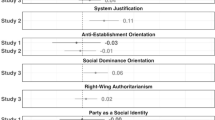Abstract
I evaluate five single-winner voting systems according to their tendency to elect Condorcet candidates under alternative models of issue voting derived from behavioral research. These behavioral models posit that voters have both issue and nonissue motivations; within this framework, I study the effects of both the directional and proximity voting models, with varying degrees of issue voting. Under the proximity metric, all voting systems are most efficient when voters attach little importance to issues, while the opposite is generally the case under directional voting. In contrast to previous results, voting systems tend to be more efficient for large than for small electorates. All voting systems – including the widely-criticized plurality method – are extremely efficient when voters in mass elections are inattentive to issues.
Similar content being viewed by others
References
Achen, C. (1978). Measuring representation. American Journal of Political Science 22: 475–510.
Adams, J. (n.d.). Condorcet efficiency and the behavioral model of the vote. The Journal of Politics. Forthcoming.
Chamberlin, J. and Cohen, M. (1978). Towards applicable social choice theory: A comparison of social choice functions under spatial model assumptions. American Political Science Review 72: 1341–1356.
Converse, P. (1964). The nature of belief systems in mass publics. In: D. Apter (Ed.), Ideology and discontent. New York: Free Press.
Converse, P. (1970). Attitudes and nonattitudes: continuation of a dialogue. In: R.E. Tufte (Ed.), The quantitative analysis of social problems. Reading, Mass.: Addison-Wesley, 1970: 168–190.
Cox, G. (1990). Multicandidate spatial competition. In: J. Enelow and M. Hinich (Eds.), Advances in the spatial theory of voting. Cambridge University Press.
Duverger, M. (1954). Political parties: Their organization and activities in the modern state. New York: Wiley.
Erikson, R. and Romero, D. (1990). Candidate equilibrium and the behavioral model of the vote. American Political Science Review 84: 1103–1126.
Iversen, T. (1994). Political leadership and representation in Western European democracies: A test of three models of voting. American Journal of Political Science 38: 45–74.
Markus, G. and Converse, P. (1979). A dynamic simultaneous equation model of electoral choice. American Political Science Review 73: 1055–1070.
Macdonald, S.E., and Rabinowitz, G. (1993). Ideology and candidate evaluation. Public Choice 76: 59–78.
Mcfadden, D. (1974). Conditional logit analysis of qualitative choice behavior. In: P. Zarembka (Ed.), Frontiers of Econometrics. Academic Press, New York.
Merrill, S. III (1981). Strategic decisions under one-stage, multicandidate voting systems. Public Choice 36: 115–139.
Merrill, S. III (1988). Making multicandidate elections more democratic. Princeton: Princeton University Press.
Merrill, S. III (1993). Voting behavior under the directional spatial model of electoral competition. Public Choice 77: 739–756.
Merrill, S. III (1994). A probabilistic model for the spatial distribution of party support in multiparty elections. Journal of the American Statistical Association 89: 1190–1197. ]
Nixon, D., Olomoki, D., Schofield, N. and Sened, I (1995). Multiparty probabilistic voting: An application to the Knesset. Political economy working paper no. 186: Washington University in St. Louis.
Nurmi, H. (1992). An assessment of voting system simulations. Public Choice 73: 459–487.
Page, B. and Jones, C. (1979). Reciprocal effects of policy preferences, party loyalties, and the vote. American Political Science Review 73: 1071–1089.
Rabinowitz, G. and Macdonald, S.E. (1989). A directional theory of issue voting. American Political Science Review 83: 93–123.
Rabinowitz, G., Macdonald, S.E. and Listhaug, O. (1991). New players in an old game. Comparative Political Studies 24: 147–185.
Rivers, D. (1988). Heterogeneity in models of electoral choice. American Journal of Political Science: 737–755.
Train, K. (1986). Qualitative choice analysis. MIT Press.
Weber, R.J. (1977). Comparison of voting systems. New Haven: Cowles Foundation Discussion paper #498A.
Author information
Authors and Affiliations
Rights and permissions
About this article
Cite this article
Adams, J. An assessment of voting systems under the proximity and directional models of the vote. Public Choice 98, 131–151 (1999). https://doi.org/10.1023/A:1018387309824
Issue Date:
DOI: https://doi.org/10.1023/A:1018387309824




